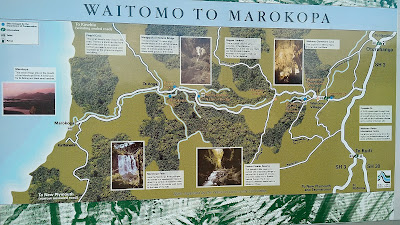 |
| Map of the Waitomo region |
Today we made it to Waitomo and the Glowworm Caves! Did you know that Waitomo is made up of two Maori words? Wai = water; and, tomo = hole. Therefore, Waitomo = waterhole. These caves are made by rain water flowing into the ground. The underlying rock is all limestone. All of NZ used to be under the sea. Limestone is made up of all the shells and coral from that time period. The rain water brings with it minerals that eat away at the limestone, which creates the caves underground. Even as we drove out to the see the caves, our guide would point out different tomos in the hills that the cows were grazing on.
 |
| On the way to Waitomo caves |
While in New Zealand, we saw a lot of cattle grazing on hills. There were sheep, too; but, there seemed to be equal numbers of cows. Interestingly, almost all cattle in NZ is free range. Even on the drive out to the caves, the guide pointed out a group of dairy cows that we just grazing up top until they would be ready to calve, at which time the dairy farmer would truck them back to the farm. Whether it’s because NZ has only 4 million people or because there are so many lush green hills or because just is this the way it’s always been done, it was very interesting to learn about.
The population of Waitomo is officially 41. However, there have been up to half million people visiting during a year. The first cave surveyed here was in 1887; and, there are now 100 surveyed caves over a length of 7 km. In comparison, the longest cave found to date is Mammoth cave in Kentucky, which is 600 km long.
 |
| At the glowworm caves |
Several of us went on the Spellbound tour, which takes a total of 13 people at a time out to a section of the Waitomo Caves under a farmer's land. The farmer has beef cows and 2500 head of sheep on the green vegetation above ground. It was nice for it to be just us in a quiet, secluded portion of the cave. We started with hardhats with headlamps on them as we walked into the cave. Our guide pointed out little green sparkles on the ceiling. Then, he had us come close to a low hanging range, where we saw lots of clear strands hanging down. A glowworm secretes 60-100 of these sticky strands from it's mouth. The bio-luminescence of the glowworm is produced by it's kidneys. This greenish light attracts bugs, which get stuck in the sticky strands. Since a glowworm turns into a fungus gnat with no mouth, it has to do all of it's eating while a larva.
 |
| Sticky strings of the glowworms |
The best part of the cave was once we got into a dinghy and turned off all our lights, cellphones and cameras. At the beginning, we could only see a scattering of green lights, much like the night sky in the city. Our guide asked us not to speak (noise disturbs the glowworms) as he pulled us silently through the subterranean water tunneling through the cave. We gazed in awe above us as the green lights increased to a carpet of light above us. When we had first switched off our headlamps, we couldn't see our hands in front of our faces. However, by the furthest point into the interior of the cave, we could make out our hands, the boat, the people next to us. This was all due to the chemical bio-luminescence of the glowworms.
 |
| Walking to the next cave |
When we finished in the glowworm cave, we had a break for hot chocolate/coffee/tea and biscuits. Extra points from me for the hot chocolate! We sat outside in the beautiful landscape then walked over to a second cave.
 |
| Flowstones |
The second cave was set-up to see the different rock formations. There was a solid boardwalk from boards made out of recycled bottles with electric lights along the way. The cave had just been opened for tours starting in 2004. We could see different formations in this cave, such as stalactites (hanging from the ceiling), stalagmites (built up from the ground), columns (when stalactites and stalagmites meet), and flowstones. Did you know that the largest part of the cave is called the "cathedral"? The largest cathedral found so far is in Vietnam and could contain an entire New York city block with all the skyscrapers.
 |
| Moa bird bones |
We also saw bones from a few creatures that had died in this cave, including a goat and a moa bird. The moa bird was a flightless bird similar to the emu that was hunted to extinction by the Maori. Before the Maori arrived, the only natural predator of the moa bird was the enormous Haast eagle with a 3 meter wingspan. Once the moa became extinct, the Haast eagle soon followed suit.
No comments:
Post a Comment